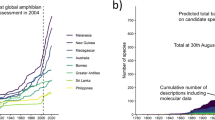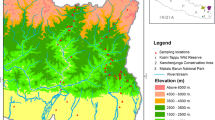Abstract
Because of their poor dispersal ability, amphibians are well suited for testing the selective extinction theory on islands. Amphibian fauna in the Zhoushan archipelago, China, exhibit a high level of nestedness (C = 0.893), and the species number is lower on islands than on similar sized areas on the mainland. No correlation was found between island-specific species richness and the nearest distance from a larger island, distance from the mainland or density of human population. These results suggest that no amphibian colonisation has occurred in the archipelago since island isolation 7000–9000 years ago. Furthermore, the results imply that selective extinction contributes to the nestedness of amphibians in the Zhoushan archipelago. The incidence of a species on the islands is significantly correlated with log area of the smallest island occupied by the species and the number of provinces on the Chinese mainland in which the species occur. However, there is no correlation with average body length of adults and island occurrence. It is concluded that (1) the area of the smallest island occupied by a species is a good estimate of the minimum area for a viable population of the species and a good predictor of species incidence on islands, (2) species with a restricted distribution range are more vulnerable to extinction from islands than those with a wide distribution range and (3) the effect of body size on occurrence on the islands is uncertain, and may be specific to the archipelago and taxa studied. The observed nestedness of amphibian assemblages has two implications for conservation: (1) not only can all the species found in several small reserves be found on a large reserve of the same total size, but additional species can be found on the single large reserve; (2) for a reserve to maintain viable populations of all species in a region it should be at least as large as the smallest island occupied by the most vulnerable species.
Similar content being viewed by others
Author information
Authors and Affiliations
Additional information
Received: 16 December 1996 / Accepted: 22 September 1997
Rights and permissions
About this article
Cite this article
Yiming, L., Niemelä, J. & Dianmo, L. Nested distribution of amphibians in the Zhoushan archipelago, China: can selective extinction cause nested subsets of species?. Oecologia 113, 557–564 (1998). https://doi.org/10.1007/s004420050409
Issue Date:
DOI: https://doi.org/10.1007/s004420050409




